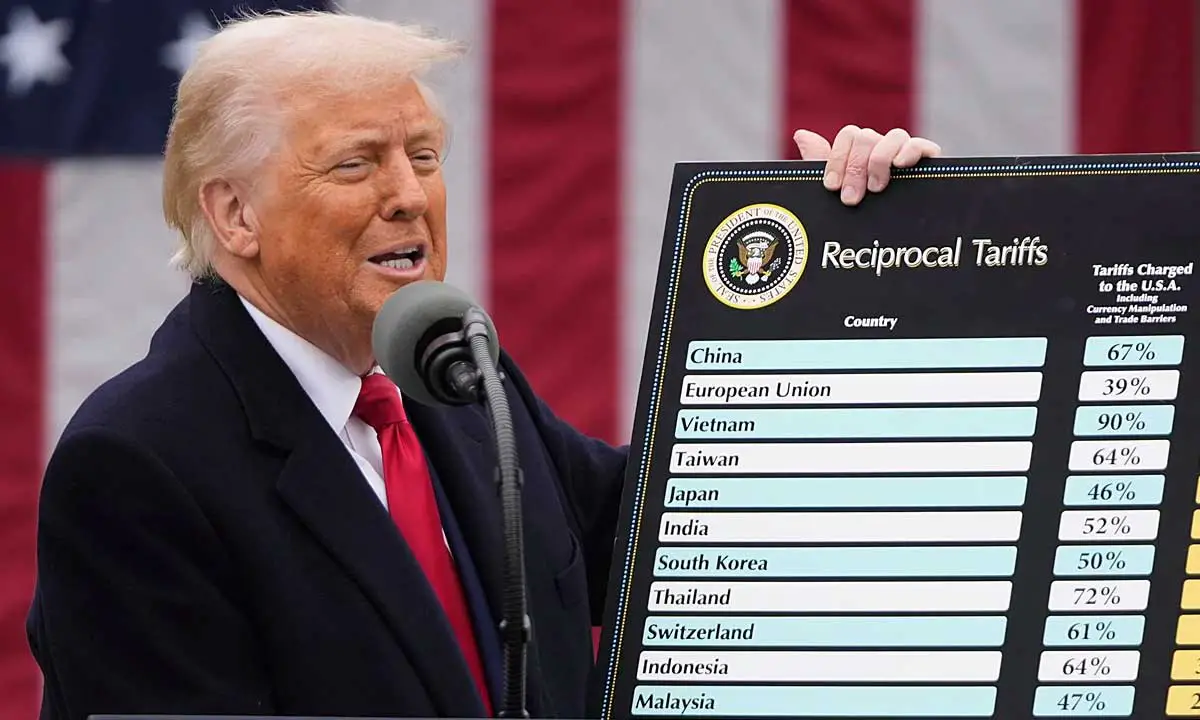Understanding Trump’s New Tariff War: Impact, Strategy & Global Reactions
The return of Donald Trump to the White House has reignited a global debate over trade policies, with the former president once again turning to aggressive tariffs as a cornerstone of his economic agenda. Rebranded as a campaign for “reciprocal tariffs,” Trump’s strategy has created significant turbulence in global trade, reshaped international relations, and sent shockwaves through U.S. business sectors—particularly retail and manufacturing.
This new era of tariff enforcement isn’t merely a repeat of his previous administration’s tactics. It has been broader, faster, and, according to critics, more unpredictable. Trump’s approach is rooted in a belief that the United States has long been on the losing side of trade relationships, particularly with countries that enjoy trade surpluses at America’s expense. But with over 190 countries potentially impacted, experts question whether this policy shift is a strategic move for economic fairness—or a reckless gamble that could backfire.
The Launch of Trump’s 2025 Tariff Strategy
In April 2025, President Trump issued a sweeping executive order that imposed a blanket 10% tariff on all goods imported into the United States. While this initial move targeted all global trade partners, additional and more severe tariffs were announced for nations that maintain substantial trade surpluses with the U.S. These measures were unveiled abruptly, without the usual diplomatic consultations or economic studies that typically precede such decisions.
Trump defended the move as necessary to protect American manufacturing and to rebalance what he termed as decades of “unfair trade practices.” However, global markets responded with uncertainty. Economists warned that such widespread tariffs could trigger retaliatory actions, damage international supply chains, and raise consumer prices domestically.
A 90-Day Window for Renegotiation
Recognizing that this seismic shift in trade policy would generate diplomatic fallout, the Trump administration introduced a 90-day pause—an opportunity for countries to renegotiate trade deals with the United States. While framed as a gesture of goodwill, the feasibility of negotiating new agreements with over 180 affected nations in such a tight window has been widely questioned.
Many diplomats noted that trade negotiations are complex and typically take months, if not years. The short timeline seemed unrealistic, leaving countries scrambling to understand Washington’s expectations and processes. Some interpreted the move as a tactical ploy rather than a genuine attempt at dialogue.
Letters Instead of Negotiations
As the 90-day deadline ticked down, Trump acknowledged the impracticality of meeting each trade partner in person. In response, the administration pivoted to a unilateral notification system. Treasury Secretary Scott Bessent and Commerce Secretary Howard Lutnick began sending formal letters to foreign governments, outlining specific tariff rates and the rationale behind them.
During a roundtable event in the United Arab Emirates, Trump explained that while the U.S. aims to be “very fair,” it lacks the capacity to engage with every nation individually. He noted that countries could appeal their tariff assignments, but offered no clear mechanism for how those appeals would be evaluated. This ambiguity has only deepened concerns among trade experts and foreign policymakers.
Early Trade Agreements: UK, India, and China
Despite the confusion, some nations have acted swiftly. On May 8, the United Kingdom became the first to strike a new bilateral trade deal with the U.S., securing tariff exemptions on key exports in exchange for greater access to the British market for American firms.
India followed closely behind. Led by Commerce Minister Piyush Goyal, Indian negotiators finalized a revised trade pact aiming to protect vital export sectors like textiles and pharmaceuticals, while making certain concessions on agricultural imports from the U.S.
The most significant breakthrough came on May 12, when the U.S. and China reached a temporary agreement after intensive negotiations in Geneva. The deal included a 90-day tariff truce, with China agreeing to purchase more American agricultural products and reduce specific trade barriers. In return, the U.S. scaled back tariffs on electronics and machinery—goods crucial to Chinese industry.
While these deals marked early successes, they also highlighted the pressure countries face to concede quickly under Trump’s compressed timeline.
Ripple Effects on American Businesses
Domestically, the ramifications of Trump’s tariff policy have been swift and far-reaching. Retail giants like Walmart, Target, Lowe’s, and Home Depot are bearing the brunt of higher import costs. These companies rely heavily on global supply chains, and the sudden increase in tariffs has disrupted pricing, inventory planning, and consumer strategies.
Target revised its financial forecasts, warning investors that although it will attempt to minimize price hikes, some product categories will see unavoidable increases. Home Depot expressed similar concerns, suggesting that certain products might be pulled from shelves altogether due to cost pressures. Lowe’s also acknowledged the challenge, stating that while it remains committed to price competition, rising supplier costs are becoming increasingly difficult to absorb.
Walmart, the world’s largest retailer, issued perhaps the most direct warning. Executives revealed that price increases would begin as early as May, directly attributing the changes to the new tariffs. Trump responded by publicly criticizing Walmart, asserting that the company should “absorb the costs” rather than pass them onto American consumers. Walmart CEO Doug McMillon countered, explaining that the company had already absorbed a significant portion of the added expenses but could not continue doing so without jeopardizing profitability.
Amazon, Mattel, and Public Scrutiny
Amazon was also caught in the crossfire. Reports emerged that the e-commerce giant was considering displaying tariff-related cost increases on its marketplace, particularly on its discount platform, Amazon Haul. The White House reacted swiftly, labeling the move as a “political stunt.” Trump personally contacted Amazon founder Jeff Bezos to voice his disapproval. Shortly after, Amazon backtracked, stating it had no plans to show tariff surcharges to consumers.
Toymaker Mattel also felt the administration’s ire. When the company announced that it would need to raise prices to offset tariff costs, Trump retaliated with a threat to impose a 100% tariff on Mattel products. He declared that if Mattel raised prices, the company would “not sell a single toy in the United States.” Such intense public pressure has had a chilling effect, making it difficult for companies to speak openly about the true cost of Trump’s trade war.
A Policy Under Fire
Beneath the headlines, economists and global trade analysts are raising serious concerns. Trump’s “reciprocal tariffs” are being implemented in a sweeping and uncoordinated fashion, leaving both American businesses and foreign governments in a state of uncertainty. Key questions remain unanswered: How are tariffs being calculated? Which products will be affected next? Can companies or countries challenge their assignments?
Many experts argue that this unpredictability undermines long-term economic planning. Trade policy, they emphasize, must be based on transparency, data, and negotiation—not executive discretion and public threats. There is growing concern that the administration’s current approach may cause lasting damage to America’s global competitiveness and its credibility as a trading partner.
India’s Delicate Balancing Act
India’s ongoing negotiations with the U.S. serve as a case study in how complex these discussions can be. While India is eager to maintain access to the American market, especially for its labor-intensive industries, it is wary of making hasty concessions that could hurt domestic interests. The arbitrary nature of Trump’s tariff assignments has left Indian officials on edge, unsure of what terms may be demanded next.
Despite the uncertainty, India is pushing for a balanced agreement—one that secures favorable terms without appearing to capitulate to Washington’s demands. However, with time running out and U.S. letters already being dispatched, New Delhi is under mounting pressure to conclude talks before tariffs take effect.
The Clock Is Ticking
With the 90-day pause nearing its expiration, more than 190 countries await official communication from Washington. Some are preparing to request bilateral meetings, while others have begun strategizing for possible retaliatory measures. The global response is fragmented, with smaller economies feeling particularly vulnerable under the shadow of unpredictable tariffs.
Trump maintains that his administration is acting in the national interest—aiming to protect American jobs, industries, and sovereignty. But critics argue that the speed and aggression of the policy rollout risks economic instability on a global scale. There’s a growing consensus that while some countries may bow to U.S. demands, others will push back, leading to trade disputes that could last for years.
Inflation, Supply Chains & Consumer Pain
The global economy is already under strain due to high inflation, geopolitical conflict, and lingering supply chain disruptions post-COVID. In this context, Trump’s tariff policy acts as a multiplier—exacerbating existing problems and potentially tipping vulnerable economies into recession. U.S. consumers are also beginning to feel the pinch, as price hikes trickle down to household budgets.
With businesses facing higher input costs, layoffs and delayed investments could follow. Industries like automotive, electronics, and agriculture—deeply dependent on international suppliers and buyers—are at the greatest risk.
Final Thoughts: A High-Stakes Gamble
Trump’s new tariff war is one of the boldest—and most controversial—economic initiatives of his second presidency. It has already altered diplomatic relations, triggered market volatility, and sparked public battles between the administration and major corporations.
Whether this strategy results in better trade deals remains to be seen. What is clear, however, is that the world is now on high alert. Countries and companies alike are bracing for the next phase of Trump’s trade doctrine. If mismanaged, this policy could usher in a period of prolonged global trade disruption, with consequences that reach far beyond America’s borders.
Read Also:

